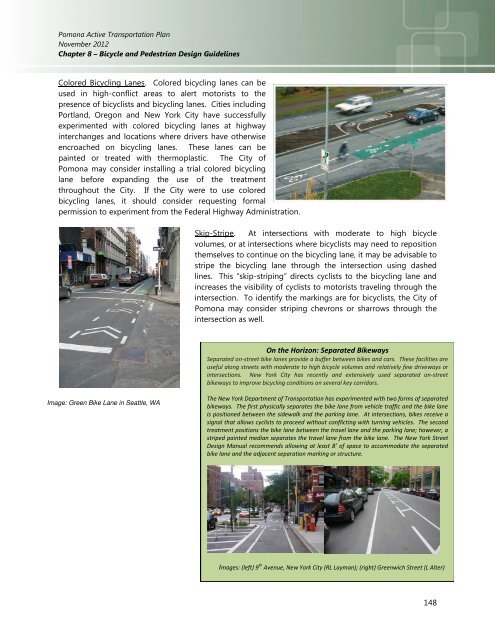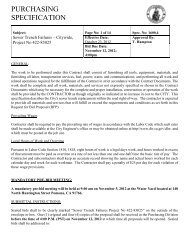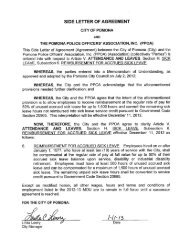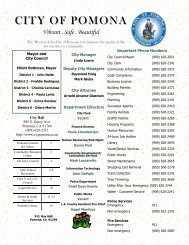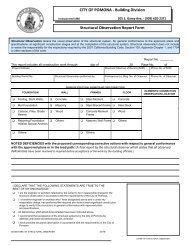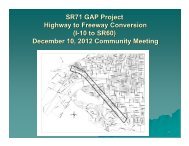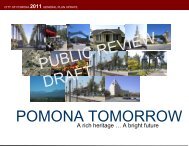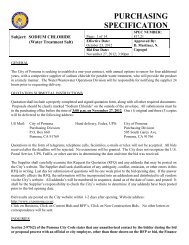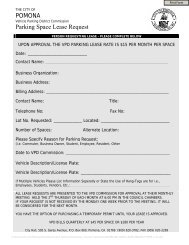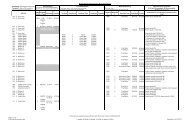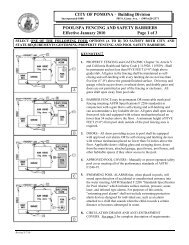Active Transportation Plan - City of Pomona
Active Transportation Plan - City of Pomona
Active Transportation Plan - City of Pomona
You also want an ePaper? Increase the reach of your titles
YUMPU automatically turns print PDFs into web optimized ePapers that Google loves.
<strong>Pomona</strong> <strong>Active</strong> <strong>Transportation</strong> <strong>Plan</strong><br />
November 2012<br />
Chapter 8 – Bicycle and Pedestrian Design Guidelines<br />
Colored Bicycling Lanes. Colored bicycling lanes can be<br />
used in high-conflict areas to alert motorists to the<br />
presence <strong>of</strong> bicyclists and bicycling lanes. Cities including<br />
Portland, Oregon and New York <strong>City</strong> have successfully<br />
experimented with colored bicycling lanes at highway<br />
interchanges and locations where drivers have otherwise<br />
encroached on bicycling lanes. These lanes can be<br />
painted or treated with thermoplastic. The <strong>City</strong> <strong>of</strong><br />
<strong>Pomona</strong> may consider installing a trial colored bicycling<br />
lane before expanding the use <strong>of</strong> the treatment<br />
throughout the <strong>City</strong>. If the <strong>City</strong> were to use colored<br />
bicycling lanes, it should consider requesting formal<br />
permission to experiment from the Federal Highway Administration.<br />
Skip-Stripe. At intersections with moderate to high bicycle<br />
volumes, or at intersections where bicyclists may need to reposition<br />
themselves to continue on the bicycling lane, it may be advisable to<br />
stripe the bicycling lane through the intersection using dashed<br />
lines. This “skip-striping” directs cyclists to the bicycling lane and<br />
increases the visibility <strong>of</strong> cyclists to motorists traveling through the<br />
intersection. To identify the markings are for bicyclists, the <strong>City</strong> <strong>of</strong><br />
<strong>Pomona</strong> may consider striping chevrons or sharrows through the<br />
intersection as well.<br />
On the Horizon: Separated Bikeways<br />
Separated on-street bike lanes provide a buffer between bikes and cars. These facilities are<br />
useful along streets with moderate to high bicycle volumes and relatively few driveways or<br />
intersections. New York <strong>City</strong> has recently and extensively used separated on-street<br />
bikeways to improve bicycling conditions on several key corridors.<br />
Image: Green Bike Lane in Seattle, WA<br />
The New York Department <strong>of</strong> <strong>Transportation</strong> has experimented with two forms <strong>of</strong> separated<br />
bikeways. The first physically separates the bike lane from vehicle traffic and the bike lane<br />
is positioned between the sidewalk and the parking lane. At intersections, bikes receive a<br />
signal that allows cyclists to proceed without conflicting with turning vehicles. The second<br />
treatment positions the bike lane between the travel lane and the parking lane; however, a<br />
striped painted median separates the travel lane from the bike lane. The New York Street<br />
Design Manual recommends allowing at least 8’ <strong>of</strong> space to accommodate the separated<br />
bike lane and the adjacent separation marking or structure.<br />
Images: (left) 9 th Avenue, New York <strong>City</strong> (RL Layman); (right) Greenwich Street (L Alter)<br />
148


